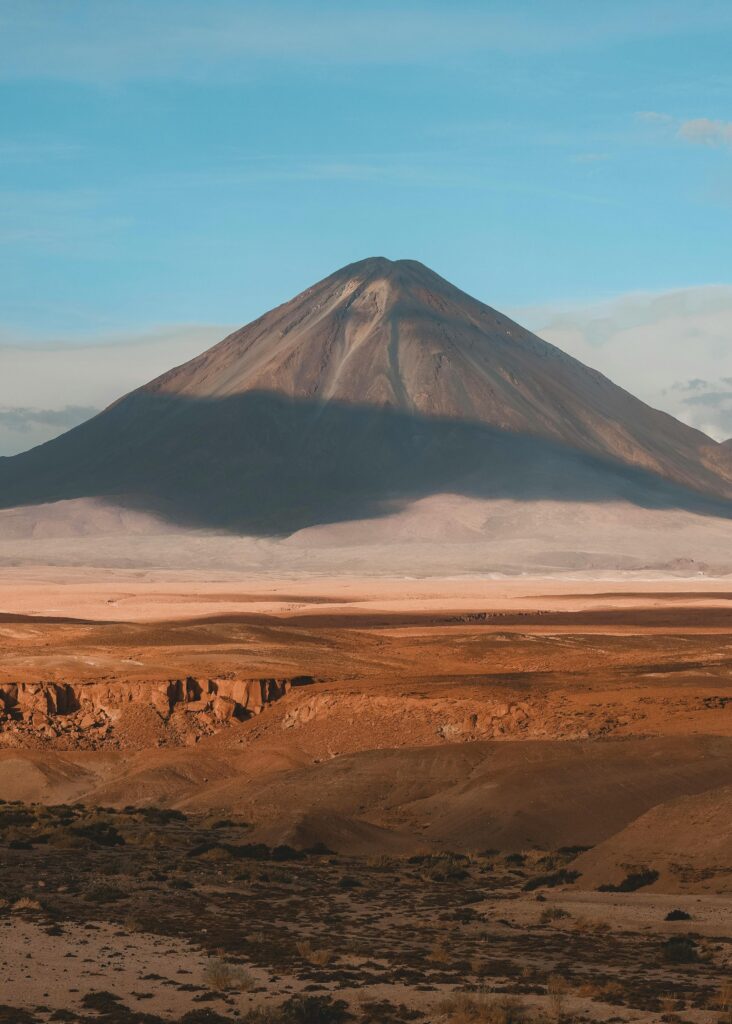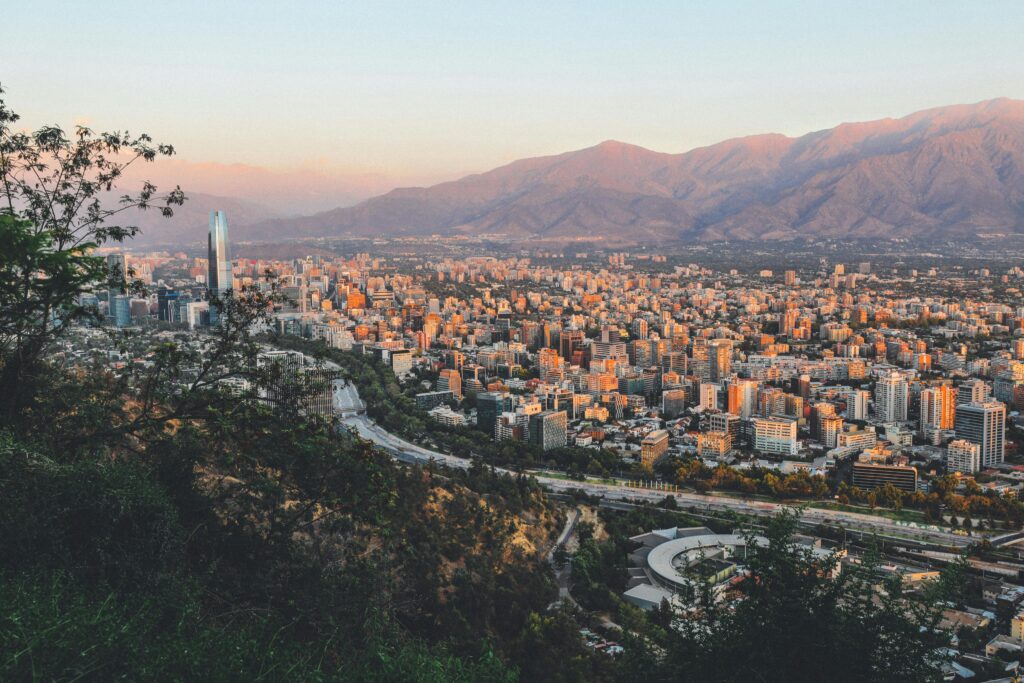Chile / República de Chile – Let’s explore here
What’s it like in Chile?
Chile is the Southernmost country in the world, bordered on the east by the Andes mountains and on the west by the Pacific Ocean. Long and narrow, it’s about twice the size of Japan. It stretches over 2,670 miles (4,300 km) north to south, but is only 109 miles (175 km) wide on average. The coastline is almost 4,000 miles long. Chile’s highest peak is the Nevado Ojos del Salado, at 22609ft (6891m), making it the highest volcano in the world.
The population of Chile is around 19 million people(2023), more than ⅓ of whom live in the metropolitan area of the capital, Santiago.
In the south of Chile there are forests, volcanoes, lakes, fjords and islands. In the north, the Atacama Desert dominates – the driest non-polar desert in the world, and is smilier to the environment on Mars! The centre of Chile, where Santiago is, experiences a Mediterranean climate.


A bit about the history of Chile
Chile’s history is characterized by Indigenous cultures, Spanish colonisation, a long struggle for independence, periods of political instability, and its emergence as a stable democracy in recent decades.
Indigenous culture
Before Spanish arrival, Chile was inhabited by various Indigenous groups, including the Mapuche, who inhabited the central and southern regions. The Inca Empire also briefly extended its influence into northern Chile, but the Mapuche fiercely resisted Inca control.
Spanish colonisation
In 1541, Spanish conquistador Pedro de Valdivia founded Santiago, marking the beginning of Chile’s colonisation. Chile became part of the Spanish Viceroyalty of Peru, and its economy was based on agriculture and mining, with a heavy reliance on Indigenous labor. However, resistance from Indigenous groups, particularly the Mapuche, led to ongoing conflicts throughout the colonial period.
Struggle for independence
Chile’s struggle for independence began in the early 19th century, influenced by other Latin American independence movements. After a series of battles, Chile formally declared its independence from Spain on February 12, 1818, following the victories of key leaders like Bernardo O’Higgins and José de San Martín. However, the country experienced internal divisions and conflicts for several years before consolidating independence.
War
Throughout the 19th century, Chile expanded its territory, including through the War of the Pacific (1879-1884), which resulted in the annexation of large areas of land from Peru and Bolivia. The conflict left Bolivia landlocked, and Chile emerged as the dominant power in the Pacific region.
Military coups
In the 20th century, Chile experienced periods of political instability, including military coups and economic challenges. The election of socialist Salvador Allende in 1970 marked a significant moment in Chilean history, as he implemented sweeping social and economic reforms. However, his government faced strong opposition, and in 1973, a military coup led by General Augusto Pinochet overthrew Allende. Pinochet’s military dictatorship (1973-1990) was marked by human rights abuses, repression, and economic reforms that favoured free-market policies.
Democracy and economic growth
In 1990, Chile transitioned back to democracy with the election of Patricio Aylwin, marking the end of Pinochet’s rule. The country experienced significant economic growth in the following decades, becoming one of the most stable and prosperous nations in Latin America.
Despite its economic progress, Chile has faced social unrest in recent years, particularly over issues of inequality, education, and pensions. In 2019, mass protests led to the process of rewriting the Chilean Constitution, which was seen as a legacy of the Pinochet era. Today, Chile is a democratic republic, recognized for its high standard of living, stable economy, and influential role in regional politics. It remains a key player in South America, with a rich cultural heritage and diverse landscapes.


Chile road trip
Our Chilean road trip is part of a much larger South American road trip.
Map of our road trip through Chile

Our current planned Chilean road trip takes us from Peru towards the capital, Santiago, before heading down to Quellon and on to Argentina.
No doubt this Pan-South American route will change once we reach Chile, so that we can explore the country in more depth.
Hopefully our journey will improve our knowledge of this intriguing and beautiful country, and enable us to meet some interesting people. We’ll be updating this page at that time – don’t forget to check back
What’s it like to drive in Chile?
They drive on the right hand side of the road in Chile. Main roads in Chile are in quite good condition, however many rural roads are very poor. Driving standards are low in Chile.
A Carnet de Passages is required to overland in Chile.
We’ve also created a dedicated page to driving abroad, which you might find helpful 🙂
Do you require an international driving permit in Chile?
We’ve created a dedicated page to driving abroad, which answers this question, and more, which you might find helpful.
Can you use your UK driving license when driving through Chile?
We’ve created a dedicated page to driving abroad, which answers this question, and more, which you might find helpful.
Do I need a carnet de passages to drive in Chile?
We’ve created a dedicated page to driving abroad, which answers this question, and more, which you might find helpful.
What currency do they use in Chile?
In Chile they use the Chilean Peso. Cash is widely used. The use of credit / debit cards is widely accepted in major cities, although not in rural areas. Travellers cheques are accepted in major cities only. There are many ATMs in cities, although not all accept foreign issued cards, and many run out of cash mid afternoon.
You should make yourself aware of the amount that your bank charges you for using credit and debit cards abroad. Often credit cards are cheaper for purchasing items directly, and for withdrawing cash from ATMs.
What language do they speak in Chile?
They speak Spanish in Chile. English is not widely spoken outside of major cities.
What time zone is Chile in?
Remember, when you’re planning your next trip to take a look at what time zone it’s in.
Do I need a visa to visit Chile?
We’ve created a dedicated, more comprehensive page on visas, which you should find helpful. Check it out!
Is wild camping legal in Chile?
Yes, wild camping is fine in Chile.
What plug / socket type do they use in Chile?
In Chile they use plug / socket types C and L.


Health issues in Chile
Is it safe to drink water in Chile?
Yes, it is safe to drink tap water in Chile. Bottled water is also readily available throughout the country.
What vaccinations are required for Chile?
This NHS website is kept up to date with all relevant information on vaccinations in Chile.
Phones in Chile
What is the country calling code for Chile?
The country calling code for Chile is +56
What are the emergency phone numbers in Chile?
- The emergency number for police in Chile is: 911 / 133 / 112
- In Chile, the emergency number for ambulance is: 131
- The emergency number for fire in Chile is: 132
If you’ve got some useful info that you’d like to share, let us know!
And don’t forget to check out all the other pictures!
